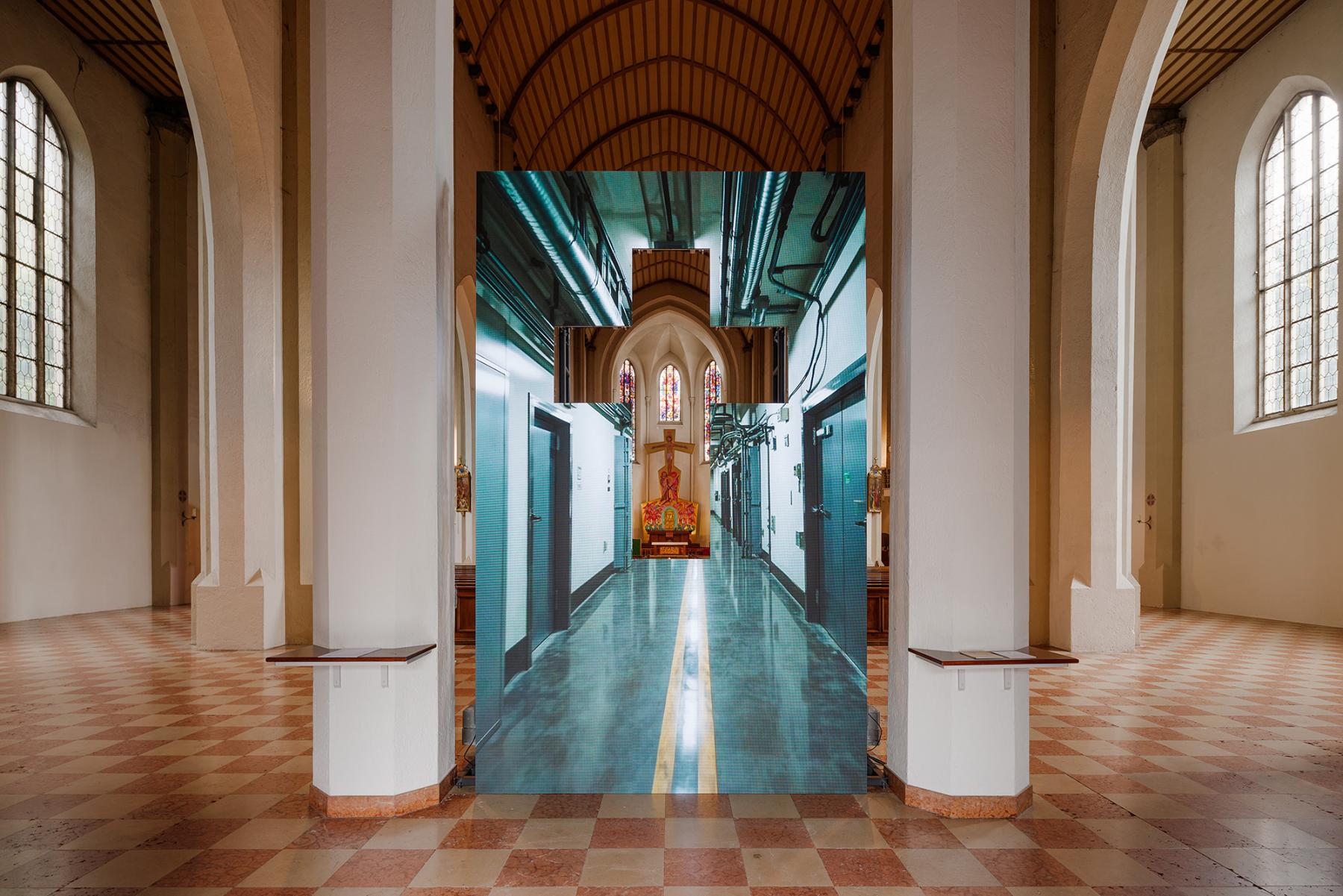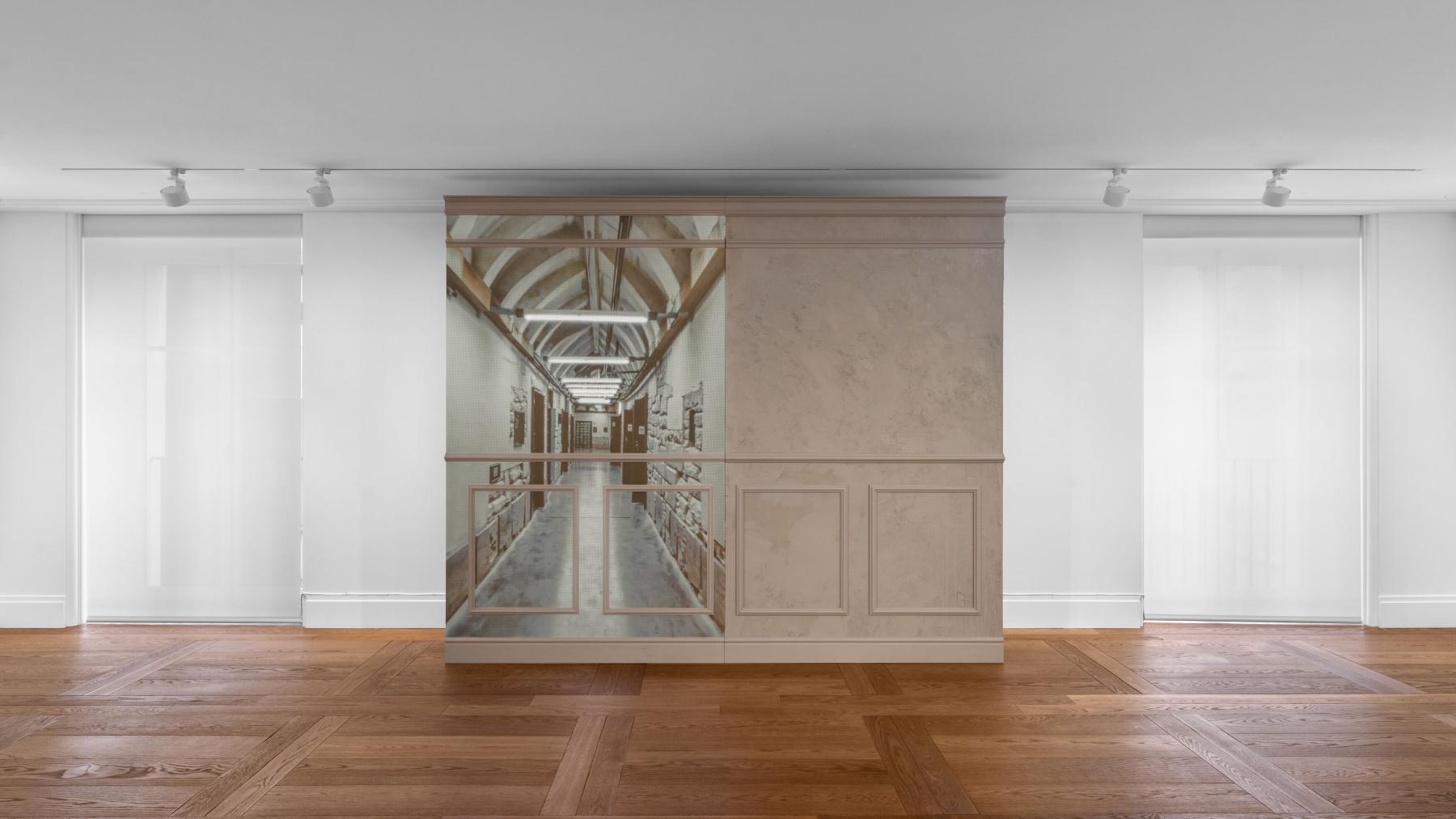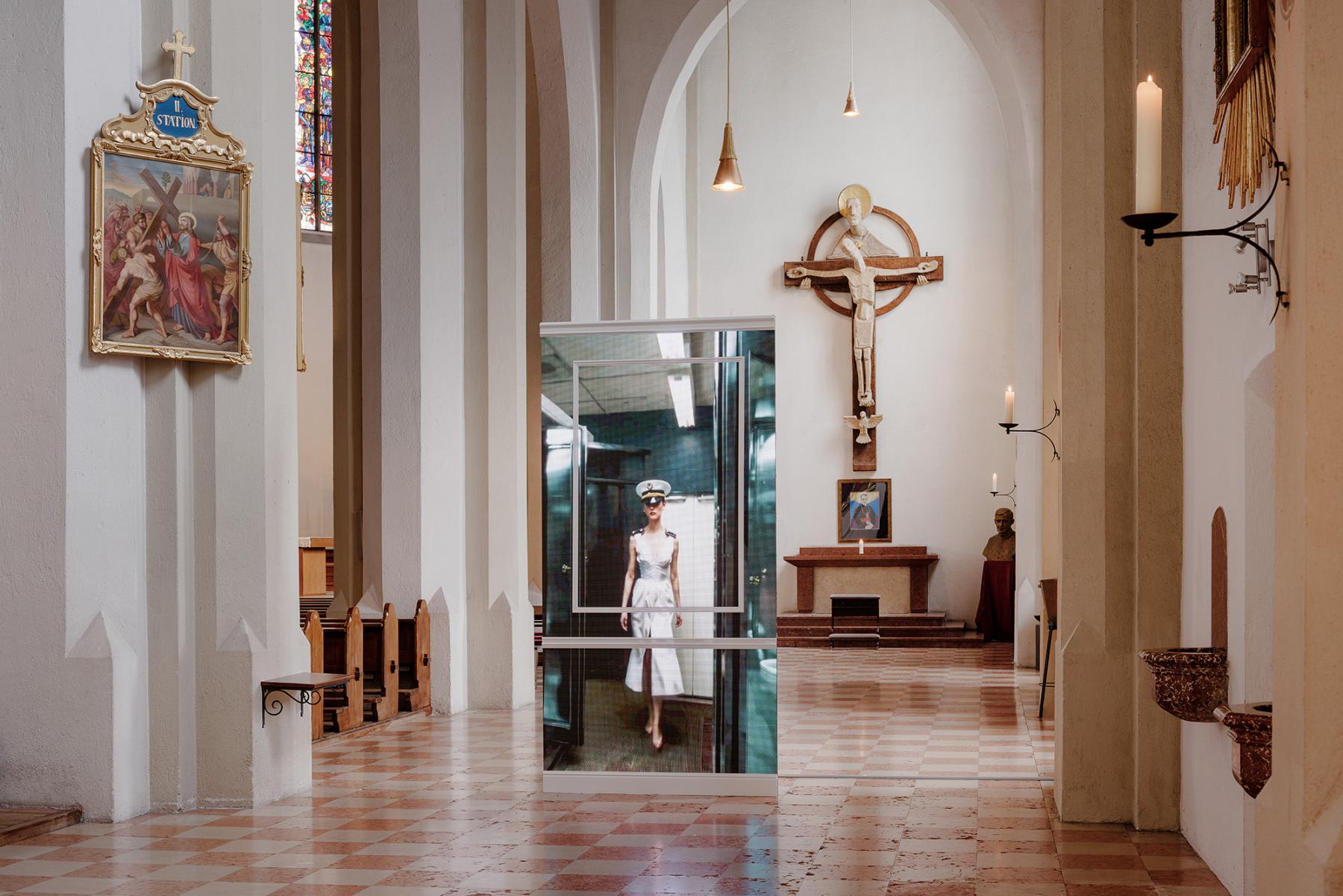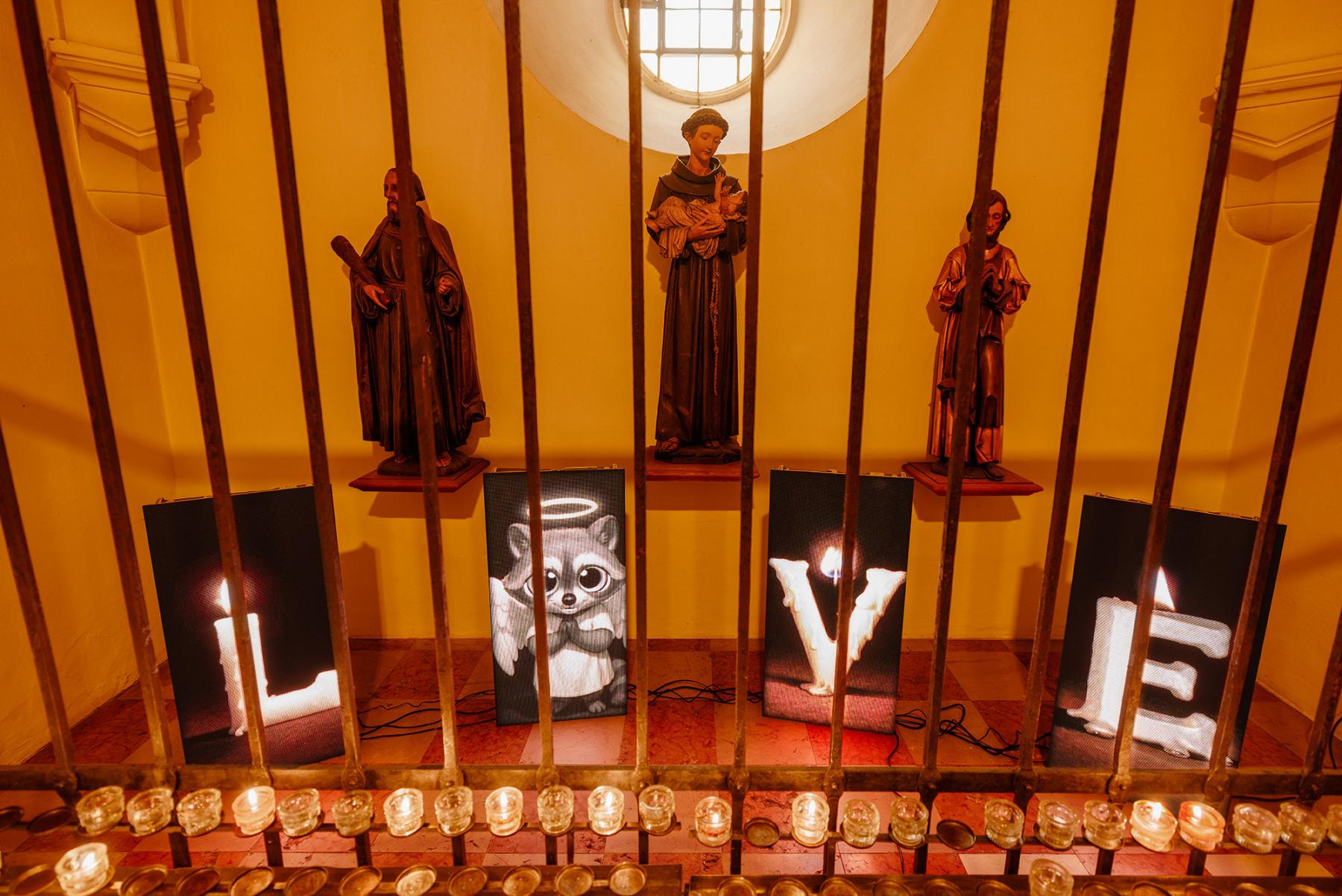
Philipp Timischl, Let the world pass, 2025. Video Installation. LED Panels, Media Processor, Laptop, videom 400×250cm. Courtesy of the artist & Layr, Vienna. Photo by Kunst-Dokumentation.com
Philipp Timischl has built a practice on making artworks that behave less like static objects and more like characters in a play. Born in Austria in 1989 and now based in Paris, he works across painting, sculpture, video, photography, and text, collapsing distinctions between media to create installations that feel at once theatrical and oddly intimate. His pieces often stage encounters with power—whether tied to class, queerness, or the structures of the art world—while remaining disarmingly playful in tone.
Timischl’s path into art was shaped by studies at the Städelschule in Frankfurt and the Academy of Fine Arts in Vienna, institutions known for producing artists eager to test the boundaries of medium. From early shows at Halle für Kunst Lüneburg (2016) and Secession in Vienna (2018), through to solo exhibitions at MGK Siegen (2023), Le Confort Moderne in Poitiers (2024), and the Museum of Contemporary Art Belgrade (2025), he has steadily built a reputation for turning the exhibition itself into a stage. His most recent presentation at Hauser & Wirth in Paris pushed this further: paintings embedded with LED screens spoke back to visitors; a large video wall narrated the tragicomic fate of a collapsing brick; and AI-generated raccoons appeared trapped in ornate frames, both humorous and unsettling.
What ties these disparate gestures together is a sense of art as performance. A painting might act hesitant, indifferent, or wounded. An installation might offer surprise—whether through its staging, its awkwardness, or even through a shot of jelly handed to viewers at the door. For Timischl, the artwork is never just an image on the wall but an entity that takes up a role, misbehaves, or shrugs at its own existence.
In the conversation that follows, Timischl is refreshingly candid about the impulses behind his work. He talks about the impostor syndrome that still shadows him, the way artworks often get fictional backstories rather than autobiographical confessions, and how drag once offered him an outlet for reinvention. There are lighter notes too: the pleasures of gym routines, the hazards of AI, and the way Paris both inspires and isolates.
Timischl belongs to a generation of artists who grew up inside image culture and now probe its contradictions from within. His installations ask what happens when images stop being vessels of meaning and start acting like us—awkward, funny, a little unreliable, but undeniably alive.
I often feel more like an imposter than an artist. And maybe I’ll never fully get rid of that feeling. Actually, I don’t even want to. It’s kind of fine, and it also shapes my practice.
Do you remember the first time you actually thought of yourself as an artist? Or maybe the first time someone else called you one? How did that feel?
Coming from a very non-academic, working-class (as in, super poor) family, with no exposure to art at all, I often feel more like an imposter than an artist. And maybe I’ll never fully get rid of that feeling. Actually I don’t even want to. It’s kind of fine, and it also shapes my practice. Still, I’ve developed a certain trust in what I do, especially in those brief moments when a work is finished or an exhibition comes together. But when I talk to people outside the art world, or get asked about my profession, I definitely prefer to lie.
Your work often feels plugged into daily life. Do you rely on small rituals to get ideas flowing—or do they just arrive uninvited?
The best ideas come randomly—like in the shower or on a walk. I can also force ideas if I need to. Deliberate naps are my trick for that. That moment right before falling asleep tends to be weirdly productive.
Identity often comes up in your work. Do you slip your own story in there, or do you prefer to keep it at a distance?
I actually prefer giving made-up identities to the artworks themselves rather than using my own. I often think of them like actors in a movie, except they’re objects in an exhibition, cast or created to play a certain role. Through the screens I use, they speak directly to the audience—not in some esoteric or metaphorical way, but quite literally, through sentences or short backstories.
Those sculptural screens are instantly recognizable in your shows. Do you see them as having a dialogue with painting, or are they just part of a larger language for you?
I don’t, really. I think of everything as part of one language. I’m not interested in positioning the screens against painting or sculpture—they just do their job within the exhibition. What matters to me is how all the elements function together in the space.
And about that language—you mix painting, sculpture, video almost without borders. What’s the thrill in letting them collapse into each other?
I don’t separate them. Again, it’s all part of one thing. Recently, I’ve been more focused on building a kind of atmosphere for visitors. But I’m less interested in immersive spectacle than in calibrated disruptions—small things like a painting hung slightly off, but also larger gestures, like a video wall you can walk through. At Hauser & Wirth last week, we gave guests jelly shots at the entrance of my exhibition. I think it helped set the tone.

Installation view, ‘Hauser & Wirth Invite(s) Philip Timischl,’ Hauser & Wirth Paris, 2025. © Philip Timischl. Courtesy of the artist, Layr and Hauser & Wirth. Photo: Nicolas Brasseur.

Philipp Timischl, Justin after everything happened, 2025. Oil and acrylic on canvas, 135×105cm. Courtesy of the artist & Layr, Vienna. Photo by Kunst-Dokumentation.com.

Philipp Timischl, Dummodo me ames, 2025. Installation view. Layr Andräkirche, Salzburg. Courtesy of the artist & Layr, Vienna. Photo by Kunst-Dokumentation.com.
Pop culture fragments, memes, media; they show up a lot in your installations. How do you decide which ones deserve a role? And what about AI: is it just another tool in the pile, or something you take seriously?
Over the last few years I’ve been using fewer references or bits of found footage. I don’t want people to need background knowledge to access the work. So I either use things that are completely unimportant, where the image just functions as itself, or references that are instantly recognizable—Kim Kardashian level famous.
AI doesn’t play a central role in my work. It’s more of a subtext around labor, outsourcing, and the automation of artistic processes. That’s what interests me, not the aesthetics. Everything AI generates for me could just as well be a found image.
Your summer show Dummodo me ames at St. Andrew’s Church in Salzburg had a raccoon singing behind steel bars. Do you like your installations to catch people off guard?
It was actually a whole choir of raccoons. Four screens. And yes, surprise is important. I find it depressing when you can’t tell if a work was made in 2025 or 20 years ago. And I’m not talking about something being timeless. I mean when it feels completely disconnected from the world we currently live in. I also love when art manages to surprise me with small things, like an unexpected way of hanging a work. Anything that looks too much like it wants to imitate art makes me suspicious.
And since it was staged in a sacred site, I have to ask—do you feel spiritual in your work, or in life?
Not at all. I’ve started going to the gym regularly over the past few years. Lifting weights is probably the closest I’ve come to anything like meditation. It helps clear my head.
On social media, you seem to shift personas a lot. Is that a kind of performance for you, maybe even another medium?
Maybe it’s the Gemini/Pisces combo. I get obsessed with the rules and behaviors of different social groups. I learn them, enjoy mimicking them, and eventually break them, I guess. It’s almost a form of class drag for me. I was the first in my family to pursue any kind of higher education, so each step—different schools, universities, being an art student—felt like stepping into a new role. Entering the art world or moving to Paris was definitely more complicated than earlier versions of that. These shifts have always happened naturally. I think I just tend to change things up when I get bored.
In a more obvious form of personal shift, I started doing drag after living in Vienna for ten years. I was just so tired of being the same person around the same people all the time. It was really fun. But as soon as I moved to Paris, I stopped. Certain parts of my life here are already so far from how I grew up, I feel like I’m in drag half the time anyway.
What was your drag name?
It was Phil up, because I was drinking a lot back then.
Your Instagram bio famously reads: Paris is literally the worst city to meet working class people. You’ve lived there for quite some time now. How is the city treating you?
I love it. It’s the first time in my life I haven’t constantly asked myself if I should be living somewhere else. It’s the perfect size, I work more, I go out less, and everything I need is close by. I couldn’t deal with hustle culture, so I’d never survive in the US. But yeah, it’s hard to find people here who come from a similar background. If you don’t already have family money or a career, Paris is not the place to start from scratch.
You just opened a show at Hauser & Wirth in Paris. What’s at the heart of it, and how does it connect with your wider practice?
The show is centered around a big video wall sculpture titled A Real True Story. It tells the story of a gray brick wall that collapses from being overworked in a skyscraper, gets fired, ends up on the street, and eventually becomes an artwork. Then there are paintings of these muscular, socialist-realist-style worker guys. But instead of working, they’re just sitting around doing nothing. I really spent a lot of time on those. And then there’s a new series of plaster-primed paintings with French decorative moldings and AI-generated raccoons—vomiting, sick, kind of emo. Those, on the other hand, were fast to make.
Why do you call these Hard Paintings?
Because they look like they’re made out of concrete, and also because painting is really hard. In brackets, I added the reason for each painting’s problem—being sick, having a headache, a cold. It’s not easy being a painting these days.
And if you weren’t making art, what do you think you’d be doing instead?
Yesterday I thought being a personal trainer could be a fun job.
I guess the gym is your other studio these days—what’s your favorite exercise?
It’s a tough call between Incline Dumbbell Press or Incline Biceps Curls. So basically anything where I can sit down.